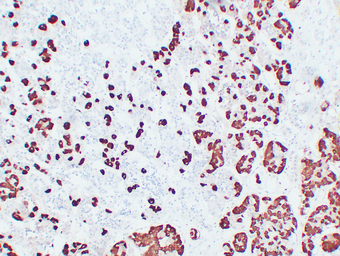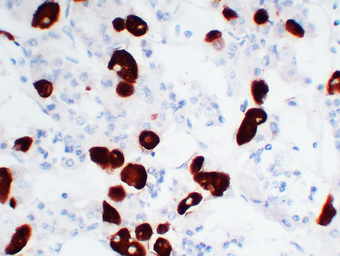Adrenocorticotropin(ACTH) (ABT-ACTH) IHC kit
- Catalog No.:IHCM6001
- Applications:IHC
- Reactivity:Human;
- Target:
- Adrenocorticotropin
- Fields:
- >>cAMP signaling pathway;>>Neuroactive ligand-receptor interaction;>>Estrogen signaling pathway;>>Melanogenesis;>>Adipocytokine signaling pathway;>>Aldosterone synthesis and secretion;>>Cortisol synthesis and secretion;>>Cushing syndrome
- Gene Name:
- POMC
- Protein Name:
- Pro-opiomelanocortin (POMC) (Corticotropin-lipotropin) [Cleaved into: NPP; Melanotropin gamma (Gamma-MSH); Potential peptide; Corticotropin (Adrenocorticotropic hormone) (ACTH); Melanotropin alpha (Al
- Human Gene Id:
- 5443
- Human Swiss Prot No:
- P01189
- Immunogen:
- Synthesized peptide derived from human Adrenocorticotropin(ACTH) AA range: 100-200
- Specificity:
- The antibody can specifically recognize human ACTH protein.
- Source:
- Mouse, Monoclonal/IgG1, kappa
- Purification:
- The antibody was affinity-purified from ascites by affinity-chromatography using specific immunogen.
- Storage Stability:
- 2°C to 8°C/1 year
- Background:
- This gene encodes a preproprotein that undergoes extensive, tissue-specific, post-translational processing via cleavage by subtilisin-like enzymes known as prohormone convertases. There are eight potential cleavage sites within the preproprotein and, depending on tissue type and the available convertases, processing may yield as many as ten biologically active peptides involved in diverse cellular functions. The encoded protein is synthesized mainly in corticotroph cells of the anterior pituitary where four cleavage sites are used; adrenocorticotrophin, essential for normal steroidogenesis and the maintenance of normal adrenal weight, and lipotropin beta are the major end products. In other tissues, including the hypothalamus, placenta, and epithelium, all cleavage sites may be used, giving rise to peptides with roles in pain and energy homeostasis, melanocyte stimulation, and immune modulation. The
- Function:
- disease:Defects in POMC are the cause of pro-opiomelanocortinin deficiency [MIM:609734]. Affected individuals present early-onset obesity, adrenal insufficiency and red hair.,disease:Defects in POMC may be associated with susceptibility to obesity [MIM:601665].,function:ACTH stimulates the adrenal glands to release cortisol.,function:Beta-endorphin and Met-enkephalin are endogenous opiates.,function:MSH (melanocyte-stimulating hormone) increases the pigmentation of skin by increasing melanin production in melanocytes.,online information:Melanocyte-stimulating hormone entry,PTM:O-glycosylated; reducing sugar is probably N-acetylgalactosamine.,PTM:Specific enzymatic cleavages at paired basic residues yield the different active peptides.,similarity:Belongs to the POMC family.,tissue specificity:ACTH and MSH are produced by the pituitary gland.,
- Subcellular Location:
- Cytoplasmic
- Expression:
- ACTH and MSH are produced by the pituitary gland.
- June 19-2018
- WESTERN IMMUNOBLOTTING PROTOCOL
- June 19-2018
- IMMUNOHISTOCHEMISTRY-PARAFFIN PROTOCOL
- June 19-2018
- IMMUNOFLUORESCENCE PROTOCOL
- September 08-2020
- FLOW-CYTOMEYRT-PROTOCOL
- May 20-2022
- Cell-Based ELISA│解您多样本WB检测之困扰
- July 13-2018
- CELL-BASED-ELISA-PROTOCOL-FOR-ACETYL-PROTEIN
- July 13-2018
- CELL-BASED-ELISA-PROTOCOL-FOR-PHOSPHO-PROTEIN
- July 13-2018
- Antibody-FAQs
- Products Images

- Human pituitary tissue was stained with anti-ACTH(ABT-ACTH) antibody.

- Human pituitary adenoma tissue was stained with anti-ACTH(ABT-ACTH) antibody.
.jpg)
- Human pituitary adenoma tissue was stained with anti-ACTH(ABT-ACTH) antibody.
.jpg)
- Human pituitary adenoma tissue was stained with anti-ACTH(ABT-ACTH) antibody.

- Human pituitary adenoma tissue was stained with anti-ACTH(ABT-ACTH) antibody.



